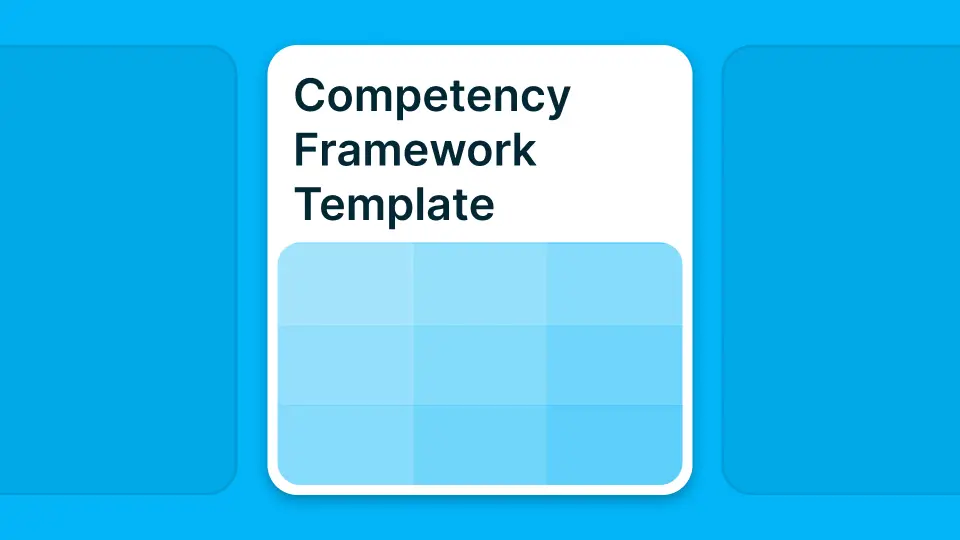Did you know that 67% of product managers say unclear expectations hold back their growth? That's not just a missed promotion—it's lost potential for your entire product organisation. Here's what you'll gain from this guide: instantly downloadable product management skills matrix templates for every role and level, concrete frameworks for evaluating and upskilling your team, and real-world guidance on avoiding the pitfalls that derail most competency initiatives.
Here's what we'll cover:
- Templates for Associate PM to Head of Product (Excel/Sheets/Notion)
- Competency families: discovery, roadmaps, OKRs, technical fluency, stakeholder management, go-to-market, pricing and more
- Proficiency scale with behavior anchors and evidence fields
- Guidance on review cycles and calibration
- Common mistakes and fixes—plus how AI can help spot skill gaps
Ready to take your product team's skills mapping from guesswork to science? Let's break it down.
1. Why Use a Product Management Skills Matrix Template?
A well-designed skills matrix clarifies expectations across product roles and empowers targeted development. When everyone knows exactly what's expected at each level, conversations about growth become concrete rather than abstract. You're not just saying "you need more leadership"—you're pointing to specific behaviors like "facilitates stakeholder workshops independently" or "defines quarterly OKRs for cross-functional teams."
Research backs this up. Teams with documented competency frameworks report 30% higher employee retention according to McKinsey's 2022 study. That makes sense: when people see a clear path forward, they're more likely to stay and grow with you rather than looking elsewhere.
Take the case of a global SaaS company with 150 employees. After introducing a structured product management competency framework, they cut onboarding time for new PMs by 25%. New hires could see exactly what success looked like at their level and what they needed to develop for the next step. No more guessing games or vague feedback loops.
Here's what a solid skills matrix delivers:
- Sets transparent criteria for each PM level so promotions feel fair
- Identifies skill gaps before they become blockers on critical projects
- Supports fair performance reviews by reducing subjective bias
- Enables focused learning plans tied to business needs
- Aligns team skills with strategic priorities as your company evolves
| Benefit | Impact on Team | Example Metric |
|---|---|---|
| Transparency | Higher trust | +15% engagement |
| Gap Identification | Targeted upskilling | Skill gap score decreases |
| Fair Reviews | Reduced bias | Promotion equity increases |
Use this as part of your broader skill management strategy. When you map competencies systematically, you're not just ticking HR boxes—you're building a foundation for sustainable team performance.
So what does a world-class PM skills matrix actually look like?
2. Anatomy of a Product Management Skills Matrix Template
The best matrices break down competencies by family, level, and proficiency—and they're practical enough to use every day. You shouldn't need a PhD to understand your own evaluation criteria. Modern frameworks like Sprad's 32,000+ skills taxonomy show how granular you can get while staying usable. The key is organizing complexity into clear categories.
Companies using granular matrices saw a 40% improvement in performance review satisfaction according to a SHRM study. That improvement comes from clarity. When someone knows they're being evaluated on "roadmap prioritization using RICE scoring" versus the vague "strategic thinking," feedback becomes actionable.
Consider a marketplace startup that built a customized Google Sheets matrix covering technical fluency and customer insight. They added specific behavior anchors like "conducts weekly user interviews" and "synthesizes insights into prioritized feature requests." The result? Their iteration cycles sped up because everyone understood what good product discovery looked like at each level.
Here's what your template structure should include:
- Core competency families: discovery and user interviews, problem framing, prioritization methods (RICE/ICE), OKRs and metrics, experimentation and A/B testing, user research and UX collaboration, technical fluency and APIs, stakeholder management and executive communications, go-to-market with Marketing/Sales/CS, delivery with Engineering/Design, pricing and packaging
- Distinct sections or tabs for Associate PM, PM, Senior PM, and Product Lead roles
- Behavior anchors for each proficiency level (like "Can independently define RICE scoring criteria for major features")
- Evidence columns where people document proof ("Link to roadmap presentation" or "Q3 OKR dashboard")
- Downloadable and editable formats—Excel, Google Sheets, or Notion work best
| Competency Family | Associate PM Example | Senior PM Example |
|---|---|---|
| Roadmapping | Follows existing roadmap and updates Jira tickets | Defines multi-quarter roadmaps based on strategic goals |
| User Research | Observes interviews and takes notes | Runs end-to-end research cycles from recruitment to synthesis |
| Technical Fluency | Basic understanding of API concepts | Leads API scoping discussions with Engineering |
| Stakeholder Management | Updates status in weekly meetings | Facilitates executive reviews and handles objections |
Make sure your templates live somewhere accessible—not buried in a SharePoint folder nobody visits. Link them from your internal wiki or skills matrix hub so people actually use them during development conversations.
But not all skills are equally important at every level. Let's look at how expectations shift as PMs grow.
3. Role Levels Explained: From Associate PM to Product Lead
Each role demands different depth across competencies—your matrix must reflect this progression clearly. The difference between a PM and Senior PM isn't just years of experience. It's about the scope of problems they tackle, the autonomy they exercise, and the influence they have on strategy.
Only 18% of organizations define clear criteria between Senior PM and Lead according to a Product Collective survey. That's a problem because without clear distinctions, you get title inflation and frustration. Someone promoted to Senior PM without understanding the new expectations will struggle—and so will their team.
At a scale-up B2B SaaS company with 80 employees, weighting strategic thinking and cross-functional alignment heavier at Lead level improved their leadership pipeline quality. They stopped promoting their best Senior PMs into Lead roles by default and started looking for specific capabilities: Can this person align three departments around a shared vision? Do they coach other PMs effectively?
Here's how to structure your levels:
- Define clear outcomes per level—not just task lists (a Lead "drives product strategy across business units" while an Associate PM "executes defined initiatives")
- Adjust competency weighting based on role expectations (stakeholder communications matter more than technical depth as you move up)
- Use separate tabs or sheets for each role in your downloadable template
- Calibrate ratings quarterly or biannually against role-specific benchmarks
- Include examples relevant to your business model—B2B SaaS PMs need different skills than mobile app PMs or marketplace PMs
| Level | Key Focus Area | Expected Evidence |
|---|---|---|
| Associate PM | Learning frameworks and contributing to execution | Participated in roadmap workshops, completed feature specs |
| PM | Owning feature areas end-to-end | Led roadmap session, shipped major feature from discovery to launch |
| Senior PM | Strategic prioritization and influence | Re-prioritized roadmap based on market shifts, influenced exec decisions |
| Product Lead | Cross-team alignment and coaching | Presented strategy to board, mentored 3 PMs to promotion |
For more detailed guidance on career progression frameworks, explore resources focused on career framework design. The principle stays the same: make expectations so clear that someone can self-assess accurately.
Now let's look at the real engine—the proficiency scale that drives meaningful assessment.
4. Proficiency Scales and Behavior Anchors: Making Ratings Actionable
Vague ratings kill clarity—a strong scale with behavior anchors ensures fairness and motivates growth. When you rate someone a "3 out of 5" on roadmapping, what does that actually mean? Can they build a roadmap alone? Do they need supervision? Can they teach others?
Anchored rating scales reduce review disagreements by up to 50% according to Harvard Business Review. That's because anchors remove ambiguity. Instead of arguing whether someone is "good" or "very good" at prioritization, you're comparing their behavior against specific descriptions.
A fintech team with 60 employees added detailed behavior anchors to their product management skills matrix template—descriptions like "Can facilitate stakeholder workshops to gather input" and "Uses RICE scoring consistently across all feature decisions." The result? Their self-assessment accuracy improved dramatically. People stopped over-rating or under-rating themselves because they had concrete reference points.
Here's how to build effective proficiency scales:
- Use a clear numeric scale (0–4 or 1–5) with behavior descriptions for each point (1 = "Observes others," 3 = "Executes independently," 5 = "Coaches and mentors others")
- Add evidence fields requiring links or artifacts for ratings above 3 (no vague claims)
- Train both managers and peers on anchor definitions before conducting reviews
- Include comment fields for context behind scores so people understand the "why"
- Review anchor relevance annually as your organization and market evolve
| Scale Point | Anchor Description | Sample Evidence |
|---|---|---|
| 1 | Observes others performing this skill | Shadowed 3 user interviews, took notes |
| 2 | Performs with close guidance | Ran interview with PM observing |
| 3 | Independently executes | Led roadmap prioritization session alone |
| 4 | Optimizes and improves processes | Improved company RICE template adopted by team |
| 5 | Coaches others and sets standards | Trained 2 new PMs on discovery methods |
Align your skills matrix with performance review templates so assessments feed directly into development conversations. When ratings have clear behavioral anchors, creating individual development plans becomes straightforward—you know exactly what competencies need work.
But how do you make sure your assessment process stays fair and actually drives improvement over time?
5. Assessment Workflow and Calibration Best Practices
Regular reviews plus calibration prevent bias and ensure data-driven development—not just box-checking exercises that waste everyone's time. The difference between a skills matrix that transforms your team and one that collects dust is how you use it. You need a systematic workflow that balances individual input with team-wide fairness.
Teams using peer plus manager reviews produce the most balanced skill assessments according to Gartner's Talent Report. Self-assessments alone skew toward either over-confidence or imposter syndrome. Manager-only reviews miss peer perspectives on collaboration and day-to-day execution. The combination gives you the full picture.
A mobile app company with 90 employees combined quarterly peer reviews with manager calibration meetings. The process took 3 hours per quarter but reduced review friction dramatically. Promotions felt fair because multiple perspectives informed every rating. People trusted the process because it wasn't one person's opinion—it was triangulated data.
Here's your assessment workflow blueprint:
- Schedule assessments quarterly or biannually—never only when someone asks for a promotion
- Weight competencies differently by role seniority (leadership and strategic thinking matter more at Lead level than for Associate PMs)
- Combine self-assessment with peer and manager input for the fullest picture
- Run calibration sessions where managers align scores across teams to prevent rating inflation or deflation
- Document outcomes in individual development plans or talent systems with clear follow-up timelines
| Step | Who's Involved | Outcome |
|---|---|---|
| Self-assessment | Individual PM | Initial score set with evidence links |
| Peer review | 2-3 team members | Bias reduction through multiple perspectives |
| Manager review | Direct manager | Performance context and development priorities |
| Calibration meeting | All PM managers plus HR | Final agreed scores aligned across teams |
For deeper analysis of skill gaps, use structured skill gap analysis templates that connect assessment results to development actions. The goal isn't just to rate people—it's to identify where investment in training or coaching will have the biggest impact on team performance.
Templates work best when tailored to your specific context. So what makes sense for your business model and stage?
6. Customizing Your Matrix by Business Model and Stage
One size doesn't fit all—a B2B SaaS product manager needs different weightings than someone building a consumer mobile app. Early-stage startups prioritize different competencies than mature enterprises. Your product management competency framework should reflect these realities or it won't drive the right behaviors.
Startups prioritize experimentation twice as much as enterprises do according to the State of Product Report. That makes sense: when you're searching for product-market fit, rapid testing matters more than perfect roadmap documentation. But as you scale, coordination and alignment become critical—your matrix must evolve with you.
Consider these real examples. A marketplace firm weighted go-to-market coordination higher because they managed two-sided dynamics—supply and demand. Their PMs needed strong cross-functional skills to balance seller experience with buyer needs. After emphasizing this in their competency framework, new hire onboarding improved and PMs ramped 30% faster.
A late-stage SaaS organization with 400 employees emphasized delivery reliability and technical fluency. They added specific behavior anchors around API design and system architecture. The result? Their incident rate dropped 25% because PMs caught technical issues earlier in the planning process.
For mobile-first products at seed stage, user feedback loops dominated the skills matrix. PMs were evaluated heavily on their ability to iterate based on app store reviews and in-app analytics. Each approach led to more focused hiring and faster time-to-impact per new hire.
Here's how to customize your template:
- Map competencies to your unique business goals—add or remove families based on what drives success for you
- Adjust proficiency anchors and examples to reflect your vertical and stage (a startup anchor might be "ships weekly experiments" while enterprise might be "coordinates quarterly release cycles")
- Reweight competencies annually as priorities shift with growth or market changes
- Benchmark against similar companies when possible but don't blindly copy their frameworks
- Keep templates editable and flexible so they evolve as your product strategy changes
| Company Type | Key Extra Focus Area | Custom Anchor Example |
|---|---|---|
| B2B SaaS | API integration and technical partnerships | "Leads cross-team API launches with external partners" |
| Marketplace | Go-to-market coordination across sides | "Balances supply and demand insights in roadmap decisions" |
| Mobile App | User feedback loop speed | "Iterates weekly based on app store data and session analytics" |
| Enterprise Software | Stakeholder alignment and change management | "Manages rollout communications across 5+ departments" |
Your product management skills matrix template should feel like it was built for your team—not borrowed from a generic HR playbook. Customization takes effort upfront but pays off in adoption and impact.
Even the best-designed matrices can fall into common traps. Let's look at how to avoid them.
7. Common Pitfalls and How AI Can Help Fix Them
Avoiding classic mistakes ensures your matrix drives real outcomes—not just busywork that frustrates your team. The most common failure mode? Creating an elaborate framework that nobody uses after the first quarter. The second most common? Focusing on the wrong things entirely.
Sixty percent of HR leaders admit their current matrices don't capture changing skill needs fast enough according to LinkedIn Talent Trends. Markets shift, technologies evolve, customer expectations change—but competency frameworks stay static for years. That gap between reality and assessment criteria kills credibility.
AI tools can help solve this problem. After automating gap analysis with Atlas AI suggestions, an international tech company with 250 employees flagged critical soft-skill gaps that manual reviews completely missed. The AI analyzed patterns across performance data, 1-on-1 meeting notes, and peer feedback to surface trends like "lack of stakeholder management skills blocking 3 major initiatives." That insight led to targeted coaching that unblocked those projects.
Here are the pitfalls to avoid:
- Don't confuse outputs ("shipped 5 features") with outcomes ("improved user retention by 15%")—always anchor to business impact
- Avoid over-complexity that makes the template unusable in daily work—if filling it out takes 2 hours, nobody will
- Update matrices regularly as market conditions and business priorities change—set calendar reminders for quarterly reviews
- Use AI tools to auto-suggest missing, new, or emerging skills based on your industry and role descriptions
- Summarize skill gaps visually so action items are obvious and prioritized
| Pitfall | Consequence | Solution |
|---|---|---|
| Output-only focus | Missed business impact | Anchor all ratings to outcomes not just activities |
| Too static | Obsolete templates within 6 months | Review and update framework every quarter |
| Manual-only process | Hidden blind spots and bias | Use AI-driven gap analysis to surface patterns |
| No follow-through | Assessment without development | Link every rating to specific development actions |
Modern platforms with large skills taxonomies (like Sprad's 32,000+ skills library) can suggest competencies you might have overlooked. For example, if you're building a B2B product but haven't included "API documentation quality" or "developer relations" in your matrix, AI can flag those gaps based on industry patterns.
The technology also helps with summarization. Instead of reading through 50 individual assessments, you get visual dashboards showing which competencies are strong across your team and which need investment. That makes resource allocation decisions straightforward.
Ready to put this into action? Here's what really matters.
Conclusion: Skills Matrices Are Your Fast Lane to Better Product Teams
Transparent product management skills matrix templates unlock fair growth pathways and make hiring and promotion decisions significantly easier. When expectations are crystal clear, you spend less time debating who deserves the next level and more time developing people to get there.
Tailoring competency families and proficiency anchors by role and business context maximizes relevance and impact. A generic framework might look impressive but won't drive the specific behaviors your company needs to win. Customization is where the value lives.
Regular calibration plus smart tools like AI close the loop between individual growth and business results. Assessment without action is wasted effort—but when you systematically identify gaps and address them, you build momentum that compounds over time.
Here are your next steps as an HR or product leader. Download customizable templates and map out current state versus future state for each team member today. Don't wait for the perfect moment—start with what you have and iterate. Involve managers and peers in regular assessments, not just once a year during review season. Make skills conversations part of your ongoing rhythm. Revisit and recalibrate weightings as your company grows, pivots, or enters new markets. Your framework should be a living document, not a monument.
As digital products evolve ever faster and hybrid teams become standard across industries, a living skills matrix will be your north star for building world-class teams. The companies that systematically develop their product talent will outpace those relying on hiring alone. Start building that advantage now.
Frequently Asked Questions (FAQ)
What is a product management skills matrix template?
A product management skills matrix template is a structured tool that outlines key competencies across different PM roles—from Associate PM up to Product Lead—with defined proficiency levels and evidence fields. It helps teams map strengths and gaps clearly using formats like Excel, Google Sheets, or Notion. The template typically includes competency families such as user research, roadmap prioritization, technical fluency, stakeholder management, and go-to-market coordination. Each competency has behavior anchors describing what performance looks like at each level, plus fields where team members document evidence of their capabilities.
How do I build an effective product manager competency framework?
Start by listing core competency families relevant to your business model—things like discovery interviews, problem framing, OKR setting, experimentation, and pricing strategy. Define expected behaviors at each career stage using anchored scales that range from learning basics up to coaching others. Add real-world evidence requirements per rating so assessments stay grounded in actual work products. Involve senior PMs and leaders in defining what success looks like at each level to ensure the framework reflects your company's unique needs. Test the framework with a small group first and iterate based on their feedback before rolling out company-wide.
Why should I calibrate my team's skill ratings regularly?
Regular calibration prevents bias from creeping into assessments over time and ensures ratings stay fair even as projects change or new people join the team. Most teams benefit from quarterly or biannual review cycles involving both peers and managers to triangulate perspectives. Calibration sessions where managers compare ratings across teams help catch inflation or deflation—one manager's "4" might be another's "3" without alignment. These sessions also surface patterns like entire teams being weak in certain areas, which helps HR prioritize training investments. Without calibration, your skills data becomes unreliable and people lose trust in the process.
How should I weight different skill areas by role level?
Adjust weights based on what success looks like at each stage of the product management career ladder. For Associate PMs, technical execution and learning agility matter most—you want to see them absorbing frameworks and contributing effectively. At the PM level, feature ownership and cross-functional collaboration carry more weight. Senior PMs need stronger strategic prioritization and influence skills since they shape roadmaps and drive alignment. At Product Lead or Head of Product level, stakeholder management, coaching, and strategic vision become the heaviest-weighted competencies. Use separate weighting tables per role in your template tabs so expectations are crystal-clear and people understand what changes as they advance.
What's the biggest mistake teams make with PM skills matrices?
The most common pitfall is focusing only on outputs like "tasks completed" or "features shipped" instead of true outcomes such as "user adoption improved" or "revenue impact delivered." This happens because outputs are easier to measure but they don't tell you if the work actually mattered. Avoid this trap by anchoring all ratings around measurable business results—not activity alone—and by updating your template regularly as company priorities shift. Another major mistake is creating an overly complex framework that nobody uses because it takes hours to fill out. Keep it practical enough for daily conversations, not just annual reviews.












